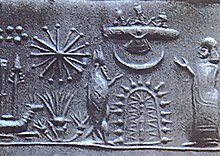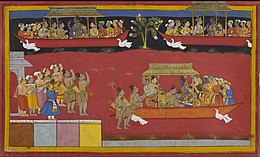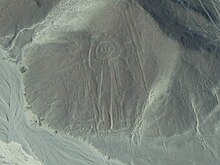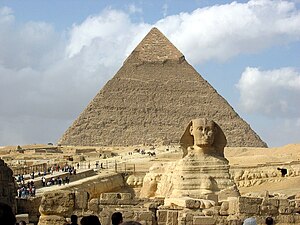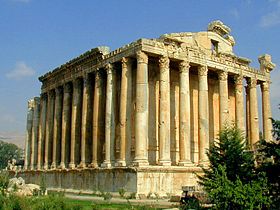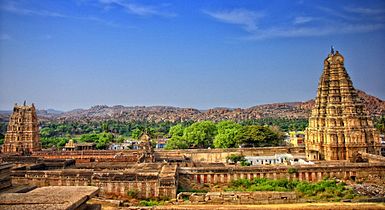
Petroglyphs from Val Camonica, Italy. Ancient astronaut proponents believe these pictures resemble modern astronauts.
| |
| Claims | Intelligent extraterrestrial life visited the Earth in ancient times and affected human civilization. |
|---|---|
| Related scientific disciplines | Archaeology |
"Ancient astronauts" (or "ancient aliens") refers to the pseudoscientific idea that intelligent extraterrestrial beings visited Earth and made contact with humans in antiquity and prehistoric times. Proponents suggest that this contact influenced the development of modern cultures, technologies, and religions, and even human biology. A common position is that deities from most, if not all, religions are extraterrestrial in origin, and that advanced technologies brought to Earth by ancient astronauts were interpreted as evidence of divine status by early humans.
The idea that ancient astronauts existed is not taken seriously by most academics, and has received no credible attention in peer reviewed studies. Furthermore, it is argued that some ancient astronaut proponents such as Erich von Däniken have fabricated evidence and distorted the facts of archeological research.
Well-known proponents in the latter half of the 20th century who have written numerous books or appear regularly in mass media include von Däniken, Zecharia Sitchin, Robert K. G. Temple, Giorgio A. Tsoukalos and David Hatcher Childress.
Overview
Ancient astronauts proponents suggest that aliens came to Earth long ago, citing artifacts such as this ancient Mesopotamian cylinder seal.
Proponents of the ancient astronaut hypothesis often maintain that humans are either descendants or creations of extraterrestrial intelligence
(ETI) who landed on Earth thousands of years ago. An associated idea
is that humans evolved independently, but that much of human knowledge,
religion, and culture came from extraterrestrial visitors in ancient
times, in that ancient astronauts acted as a "mother culture".
Some ancient astronaut proponents also believe that travelers from
outer space, referred to as "astronauts" (or "spacemen") built many of
the structures on Earth (such as Egyptian pyramids and the Moai stone heads of Easter Island) or aided humans in building them.
Various terms are used to reference claims about ancient astronauts, such as ancient aliens, ancient ufonauts, ancient space pilots, paleocontact, astronaut- or alien gods, or paleo- or Bible-SETI (search for extraterrestrial intelligence).
Ancient astronauts hypothesis of creation
Proponents
argue that the evidence for ancient astronauts comes from documentary
gaps in historical and archaeological records, and they also maintain
that absent or incomplete explanations of historical or archaeological
data point to the existence of ancient astronauts. The evidence is
argued to include archaeological artifacts that they deem anachronistic,
or beyond the accepted technical capabilities of the historical
cultures with which they are associated. These are sometimes referred
to as "out-of-place artifacts";
and include artwork and legends which are interpreted in a modern sense
as depicting extraterrestrial contact or technologies.
Scholars have responded that gaps in contemporary knowledge are
not evidence of the existence of ancient astronauts, and that advocates
have not provided any convincing anecdotal or physical evidence of an
artifact that might conceivably be the product of ETI contact. According
to astrophysicist Carl Sagan,
"In the long litany of 'ancient astronaut' pop archaeology, the cases
of apparent interest have perfectly reasonable alternative explanations,
or have been misreported, or are simple prevarications, hoaxes and distortions".
Hypothesis origins and proponents
Paleocontact or "ancient astronaut" narratives first appeared in the early science fiction of the late 19th to early 20th century. The idea was proposed in earnest by Harold T. Wilkins
in 1954; it received some consideration as a serious hypothesis during
the 1960s. Critics of the theory emerged throughout the 1970s,
discrediting Von Daniken's theory.
Ufologists separated the idea from the UFO controversy. By the early
1980s little remaining support of the theory could be found.
Shklovski and Sagan
Votive relief of the winged priest of Dudu on display at the Louvre Museum, France.
In Intelligent Life in the Universe (1966) astrophysicists I. S. Shklovski and Carl Sagan
devote a chapter to the argument that scientists and historians should
seriously consider the possibility that extraterrestrial contact
occurred during recorded history; however, Shklovski and Sagan stressed
that these ideas were speculative and unproven. Shklovski and Sagan argued that sub-lightspeed interstellar travel by extraterrestrial life was a certainty when considering technologies that were established or feasible in the late 1960s; that repeated instances of extraterrestrial visitation to Earth were plausible; and that pre-scientific narratives can offer a potentially reliable means of describing contact with aliens.
Sagan illustrates this hypothesis by citing the 1786 expedition of French explorer Jean-François de Galaup, comte de La Pérouse, which made the earliest first contact between European and Tlingit cultures. The contact story was preserved as an oral tradition by the preliterate Tlingit. Over a century after its occurrence it was then recorded by anthropologist George T. Emmons.
Although it is framed in a Tlingit cultural and spiritual paradigm,
the story remained an accurate telling of the 1786 encounter. According
to Sagan, this proved how "under certain circumstances, a brief contact
with an alien civilization will be recorded in a re-constructible
manner. He further states that the reconstruction will be greatly aided
if 1) the account is committed to written record soon after the event;
2) a major change is effected in the contacted society; and 3) no
attempt is made by the contacting civilization to disguise its exogenous
nature."
Additionally, Shklovski and Sagan cited tales of Oannes,
a fishlike being attributed with teaching agriculture, mathematics, and
the arts to early Sumerians, as deserving closer scrutiny as a possible
instance of paleocontact due to its consistency and detail.
In his 1979 book Broca's Brain,
Sagan suggested that he and Shklovski might have inspired the wave of
1970s ancient astronaut books, expressing disapproval of "von Däniken
and other uncritical writers" who seemingly built on these ideas not as
guarded speculations but as "valid evidence of extraterrestrial
contact." Sagan argued that while many legends, artifacts, and purported out-of-place artifacts
were cited in support of ancient astronaut hypotheses, "very few
require more than passing mention" and could be easily explained with
more conventional hypotheses. Sagan also reiterated his earlier
conclusion that extraterrestrial visits to Earth were possible but
unproven, and improbable.
Erich von Däniken
According to Erich von Däniken, the Sarcophagus lid of Pacal the Great represents an "ancient astronaut" ascending to the stars in his spaceship.
Erich von Däniken was a leading proponent of this hypothesis in the
late 1960s and early 1970s, gaining a large audience through the 1968
publication of his best-selling book Chariots of the Gods? and its sequels.
According to von Däniken, certain artifacts require a more
sophisticated technological ability in their construction than that
which was available to the ancient cultures who constructed them. Von
Däniken maintains that these artifacts were constructed either directly
by extraterrestrial visitors or by humans who learned the necessary
knowledge from said visitors. These include Stonehenge, Pumapunku, the Moai of Easter Island, the Great Pyramid of Giza, and the ancient Baghdad electric batteries.
The so-called "Helicopter hieroglyphs", at Abydos, Egypt, which are argued to depict flying craft
Von Däniken writes that ancient art and iconography
throughout the world illustrates air and space vehicles, non-human but
intelligent creatures, ancient astronauts, and artifacts of an
anachronistically advanced technology. Von Däniken also states that
geographically separated historical cultures share artistic themes,
which he argues imply a common origin. One such example is von Däniken's
interpretation of the sarcophagus lid recovered from the tomb of the
Classic-era Maya ruler of Palenque, Pacal the Great. Von Däniken writes that the design represented a seated astronaut. The iconography and accompanying Maya text, however, identifies it as a portrait of the ruler himself with the World Tree of Maya mythology.
The origins of many religions are interpreted by von Däniken as
reactions to encounters with an alien race. According to his view,
humans considered the technology of the aliens to be supernatural and the aliens themselves to be gods.
Von Däniken states that the oral and written traditions of most
religions contain references to alien visitors in the way of
descriptions of stars and vehicular objects travelling through air and
space. One such is Ezekiel's revelation in the Old Testament, which Däniken interprets as a detailed description of a landing spacecraft (The Spaceships of Ezekiel).
Von Däniken's hypotheses became popularized in the U.S. after the NBC-TV documentary In Search Of Ancient Astronauts hosted by Rod Serling and the film Chariots of the Gods.
Critics argue that von Däniken misrepresented data, that many of
his claims were unfounded, and that none of his core claims have been
validated. In particular the Christian creationist community is highly critical of many of von Däniken's work. Young Earth creationist author Clifford A. Wilson published Crash Go the Chariots in 1972 in which he attempted to discredit all the claims made in Chariots of the Gods.
Zecharia Sitchin
Zecharia Sitchin's series The Earth Chronicles, beginning with The 12th Planet, revolves around Sitchin's unique interpretation of ancient Sumerian and Middle Eastern texts, megalithic sites, and artifacts from around the world. He hypothesizes that the gods of old Mesopotamia were astronauts from the planet "Nibiru", which Sitchin states the Sumerians believed to be a remote "12th planet" (counting the Sun, Moon, and Pluto as planets) associated with the god Marduk. According to Sitchin, Nibiru continues to orbit our sun on a 3,600-year elongated orbit. Modern astronomy has found no evidence to support Sitchin's ideas.
Sitchin argues that there are Sumerian texts which tell the story that 50 Anunnaki,
inhabitants of a planet named Nibiru, came to Earth approximately
400,000 years ago with the intent of mining raw materials, especially
gold, for transport back to Nibiru. With their small numbers they soon
grew tired of the task and set out to genetically engineer laborers to
work the mines. After much trial and error they eventually created Homo sapiens sapiens: the "Adapa" (model man) or Adam
of later mythology. Sitchin contended the Anunnaki were active in human
affairs until their culture was destroyed by global catastrophes caused
by the abrupt end of the last ice age
some 12,000 years ago. Seeing that humans survived and all they had
built was destroyed, the Anunnaki left Earth after giving humans the
opportunity and means to govern themselves. Sitchin's work has not
received mainstream scholarly support and has been roundly criticized by
professionals that have reviewed his hypotheses. Semitic languages scholar Michael S. Heiser
says that many of Sitchin's translations of Sumerian and Mesopotamian
words are not consistent with Mesopotamian cuneiform bilingual
dictionaries, produced by ancient Akkadian scribes.
Alan F. Alford, author of Gods of the New Millennium
(1996), was an adherent of the ancient astronaut hypothesis. Much of
his work draws on Sitchin's hypotheses. However, he now finds fault with
Sitchin's hypothesis after deeper analysis, stating that: "I am now
firmly of the opinion that these gods personified the falling sky; in
other words, the descent of the gods was a poetic rendition of the
cataclysm myth which stood at the heart of ancient Near Eastern
religions."
Robert Temple
Robert K. G. Temple's 1976 book, The Sirius Mystery argues that the Dogon people of northwestern Mali
preserved an account of extraterrestrial visitation from around 5,000
years ago. He quotes various lines of evidence, including advanced
astronomical knowledge inherited by the tribe, descriptions, and
comparative belief systems with ancient civilizations such as ancient Egypt and Sumer. His work draws heavily on the studies of cultural anthropologists Marcel Griaule and Germaine Dieterlen.
His conclusions have been criticized by scientists, who point out
discrepancies within Temple's account, and suggested that the Dogon may
have received some of their astronomical information recently, probably
from European sources, and may have misrepresented Dogon ethnography.
UFO religions
Various new religious movements including some branches of theosophy, Scientology, Raëlism, and Heaven's Gate
believe in ancient and present-day contact with extraterrestrial
intelligence. Many of these faiths see both ancient scriptures and
recent revelations as connected with the action of aliens from other
planetary systems. Psychologists have found that UFO religions have
similarities which suggest that members of these groups consciously or subliminally associate enchantment with the memes of science fiction.
Evidence cited by proponents
Rama being welcomed upon his return to Ayodhya in king Ravana's flying chariot Pushpaka Vimana.
Among scientists, the consensus is that the ancient astronaut hypothesis is not per se
wrong, but unnecessary. The "mysteries" cited as evidence for the
hypothesis can be explained without having to invoke ancient astronauts;
proponents look for mysteries where none exist. Since ancient astronauts are unnecessary, Occam's razor should be applied and the hypothesis rejected according to the scientific consensus.
Ancient religious texts
Proponents
cite ancient mythologies to support their viewpoints based on the idea
that ancient creation myths of gods who descend from the heavens to
Earth to create or instruct humanity are representations of alien
visitors, whose superior technology accounts for their perception as
gods. Proponents draw an analogy to occurrences in modern time when
isolated cultures are exposed to Western technology, such as when, in
the early 20th century, "cargo cults"
were discovered in the South Pacific: cultures who believed various
Western ships and their cargo to be sent from the gods as fulfillment of
prophecies concerning their return.
The ancient Sumerian myth of Enûma Eliš, inscribed on cuneiform tablets and part of the Library of Ashurbanipal, says humankind was created to serve gods called the "Annunaki".
Hypothesis proponents believe that the Annunaki were aliens who came to
earth to mine gold for their own uses. According to the Enuma Elish
story, the Annunaki realized mining gold was taking a toll on their
race, and then created the human race as slaves.
The scholar of Christ mythicism Dorothy Murdock
criticized ancient astronauts theories, asserting that they "may be
prompted by the same type of motivation that produced the Bible, a
chronicle largely consisting of the plagiarized myths of other cultures"
refashioned as historical facts concerning purported historical
characters, and may be driven by the attempt to validate Biblical
mythology as historical under a new pseudo-scientific interpretation.
Ramayana
In Hindu mythology, the gods and their avatars travel from place to place in flying vehicles (see Vimana). There are many mentions of these flying machines in the Ramayana, which used by Tamil king Ravana from Sri Lanka dates to the 5th or 4th century BCE. Below are some examples.
From Book 6, Canto CXXIII: The Magic Car:
Is not the wondrous chariot mine,
Named Pushpak, wrought by hands divine.
…
This chariot, kept with utmost care,
Will waft thee through the fields of air,
And thou shalt light unwearied down
In fair Ayodhyá's royal town.
From Book 6, Canto CXXIV: The Departure:
Swift through the air, as Ráma chose,
The wondrous car from earth arose.
And decked with swans and silver wings
Bore through the clouds its freight of kings.
Erich von Däniken discusses the Ramayana and the vimanas in Chapter 6 of Chariots of the Gods?
suggesting that they were "space vehicles". To support his hypothesis,
he offers a quotation which he says is from an 1889 translation of the Mahabharata by C. Roy: "Bhima flew with his Vimana on an enormous ray which was as brilliant as the sun and made a noise like the thunder of a storm".
Book of Genesis and Book of Enoch
The Book of Genesis, Chapter 6 verses 1-2 and 4, states:
When human beings began to increase in number on the earth and daughters were born to them, the sons of God saw that the daughters of humans were beautiful, and they married any of them they chose.
...
The Nephilim were on the earth in those days—and also afterward—when the sons of God went to the daughters of humans and had children by them.
— Genesis 6:1–4 (New International Version)
Many Christians consider these groups to be the different families of
Adam and Eve's children. Another interpretation is that the Nephilim
are the children of the "sons of God" and "daughters of humans",
although scholars are uncertain. The King James Version translates "Nephilim" as "giants" (or Gibborim). Ancient Astronaut theorists argue that Adam and Eve ate of the forbidden fruit in order "to be godlike", and this was the first step in human evolution.
The first part of the apocryphal Book of Enoch expands and interprets Genesis 6:1: that the "sons of God" were a group of 200 "angels" called "Watchers",
who descended to Earth to breed with humans. Their offspring are the
Nephilim, "giants" who "consumed all the acquisitions of men". When
humans could no longer sustain the Nephilim, they turned against
humanity. The Watchers also instructed humans in metallurgy and metalworking, cosmetics, sorcery, astrology, astronomy, and meteorology. God then ordered the Watchers to be imprisoned in the ground, and created the Great Flood (or the numerous Deluge myths) to rid Earth of the Nephilim and of the humans given knowledge by the Watchers. To ensure humanity's survival, Noah is forewarned of the oncoming destruction. Because they disobeyed God, the book describes the Watchers as "fallen angels".
Some ancient astronaut proponents argue that this story is a
historical account of extraterrestrials visiting Earth, called Watchers
because their mission was to observe humanity. Some of the
extraterrestrials disobeyed orders; they made contact with humans,
cross-bred with human females, and shared knowledge with them. The
Nephilim were thus half-human-half-extraterrestrial hybrids.
Chuck Missler and Mark Eastman argue that modern UFOs carry the
fallen angels, or offspring of fallen angels, and that "Noah's genealogy
was not tarnished by the intrusion of fallen angels. It seems that
this adulteration of the human gene pool was a major problem on the
planet earth".
Von Däniken also suggests that the two angels who visited Lot in Genesis 19 were ancient astronauts, who used atomic weapons to destroy the city of Sodom.
Marc Dem reinterprets the Book of Genesis by writing that
humanity started on another planet and that the God of the Bible is an
extraterrestrial.
Book of Ezekiel
An engraved illustration of Ezekiel's 'vision' (1670)
In the Old Testament, Chapter 1 of the Book of Ezekiel
recounts a vision in which Ezekiel sees "an immense cloud" that
contains fire and emits lightning and "brilliant light". It continues:
"The center of the fire looked like glowing metal, and in the fire was
what looked like four living creatures". These creatures are described
as winged and humanoid, they "sped back and forth like flashes of
lightning" and "fire moved back and forth among the creatures". The
passage goes on to describe four shiny objects, each appearing "like a
wheel intersecting a wheel". These objects could fly and they moved with
the creatures: "When the living creatures moved, the wheels beside them
moved; and when the living creatures rose from the ground, the wheels
also rose".
In Chapter 4 of Chariots of the Gods?, entitled "Was God
an Astronaut?", von Däniken suggests that Ezekiel had seen a spaceship
or spaceships; this hypothesis had been put forward by Morris Jessup in 1956 and by Arthur W. Orton in 1961. A detailed version of this hypothesis was described by Josef F. Blumrich in his book The Spaceships of Ezekiel (1974).
Elsewhere in the Bible
The characteristics of the Ark of the Covenant and the Urim and Thummim have been said to suggest high technology, perhaps from alien origins.
Robert Dione and Paul Misraki published books in the 1960s describing the events in the Bible as caused by alien technology. Barry Downing, a Presbyterian minister, wrote a book in 1968 arguing that Jesus was an extraterrestrial, citing John 8:23 and other biblical verses as evidence.
Some ancient astronaut proponents such as Von Däniken and Barry Downing believe that the concept of hell in the Bible could be a real description of the planet Venus brought to Earth by extraterrestrials showing photos of the hot surface on Venus to humans. Proponents of the hypothesis state that 'God' and 'Satan'
were aliens that disagreed on whether or not human beings should be
allowed the information that is offered by the tree of knowledge. David Childress, a leading proponent of ancient astronaut creation hypothesis, compares this story to the Greek tale of Prometheus,
who gave mankind the knowledge of fire. Ancient Astronaut theorists
believe the biblical concept of Satan is based on a misunderstood visit
by extraterrestrials. Erich von Däniken posited that the descendants of extraterrestrials had children with hominids, and this was referred to in the Bible as the "Original sin." Von Däniken believes that the biblical great flood was punishment after an extraterrestrial 'God' discovered that earthbound, fallen angels were mating with ape-like early humans.
Irish Book of Invasions
Childress and others have written that the passage in the Book of Invasions describing the arrival of the Tuatha Dé Danann in Ireland, records "the arrival of aliens in spacecraft with cloaking devices" at Slieve Anierin.
The key text states “so that they were the Tuatha De Danand who came to
Ireland. In this wise they came, in dark clouds. They landed on the
mountains of Conmaicne Rein in Connacht and they brought a darkness over
the sun for three days and three nights".
Ancient artwork
Comparison of some Ural pictograms to modern structural formulae of several chemical compounds (according to Russian researcher Vladimir Avinsky)
Worldwide petroglyphic evidence
Ancient astronaut theorists believe Hopi cave drawings of Kachinas (spirit beings) found in the desert link the origins of Hopi and Zuni
tribes with "star people". They point to similar etchings elsewhere as
evidence that extraterrestrials visited many different ancient
civilizations.
Other artistic support for the ancient astronaut hypothesis has been sought in Palaeolithic cave paintings. Wondjina in Australia and in the Rock Drawings in Valcamonica, in Italy (seen above) are said to bear a resemblance to present day astronauts.
Supporters of the ancient astronaut hypothesis sometimes argue that
similarities such as dome shaped heads, interpreted as beings wearing
space helmets, prove that early man was visited by an extraterrestrial
race.
More support of this hypothesis draws upon what are said to be representations of flying saucers in medieval and renaissance art.
Nazca Lines
A large geoglyph near the Nazca Lines, thought by some to represent an astronaut
The ancient Nazca Lines are hundreds of huge ground drawings etched into the high desert of southern Peru.
Some are stylized animals and humanoid figures, while others are merely
straight lines hundreds of meters long. As the figures were made to be
seen from a great height, they have been linked with the ancient
astronaut hypothesis. In the 1970s, the pseudohistorical writer Erich von Däniken
popularized a notion that the Nazca lines and figures could have been
made "according to instructions from aircraft" and that the longer and
wider lines might be runways for spacecraft. According to archaeologist Kenneth Feder,
Von Däniken's extraterrestrial interpretation is not supported by any
evidence. Feder wrote that "the lines are interpreted by archaeologists
as ceremonial pathways of the ancient Nazca people; they were used
precisely in this way in the fairly recent past."
Joe Nickell of the University of Kentucky was able to re-create one of the figures using only wooden stakes and string.
Ancient artifacts
Proponents of the ancient astronauts idea say some artifacts discovered in Egypt (the Saqqara Bird) and Colombia-Ecuador are similar to modern planes and gliders. These artifacts have been interpreted by mainstream archaeologists, however, as stylized representations of birds and insects.
Megalithic sites
Ahu Tongariki near Rano Raraku; ancient astronaut proponents state that the stone structures were built by (or with the help of) extraterrestrials
Proposed evidence for ancient astronauts includes the existence of ancient monuments and megalithic ruins such as the Giza pyramids of Egypt, Machu Picchu in Peru, or Baalbek in Lebanon, the Moai of Easter Island and Stonehenge of England.
Supporters say that these stone structures could not have been built
with the technical abilities and tools of the people of the time and
further argue that many could not be duplicated even today. They suggest
that the large size of the building stones, the precision with which
they were laid, and the distances many were transported leaves the
question open as to who constructed these sites.
These ideas are categorically rejected by mainstream archeology. Some mainstream archeologists have participated in experiments to move large megaliths. These experiments have succeeded in moving megaliths up to at least 40 tons, and they have speculated that with a larger workforce larger megaliths could be towed with the use of known ancient technology. Such allegations are not unique in history, however, as similar reasoning lay behind the wonder of the Cyclopean masonry walling at Mycenaean cities in the eyes of Greeks of the following "Greek Dark Ages", who believed that the giant Cyclops had built the walls.
Religious and cultural practices
A number of ancient cultures, such as the Ancient Egyptians and some Native Americans, artificially lengthened
the skulls of their children. Some ancient astronaut proponents propose
that this was done to emulate extraterrestrial visitors, whom they saw
as gods. Among the ancient rulers depicted with elongated skulls are pharaoh Akhenaten and Nefertiti. It has been pointed out that the Grey aliens, as described by many alien abductees, have similarly shaped heads. In the program Ancient Aliens it was suggested that the owners of the biggest of the lengthened skulls may be human-extraterrestrial hybrids.
In popular culture
Ancient astronauts have been addressed frequently in science fiction
and horror fiction in many different media. In a 2004 article in Skeptic magazine, Jason Colavito writes that von Däniken borrowed many of the book's concepts from Le Matin des Magiciens (Morning of the Magicians), that this book in turn was heavily influenced by the Cthulhu Mythos, and that the core of the ancient astronaut hypothesis originates in H. P. Lovecraft's works "The Call of Cthulhu" and At the Mountains of Madness. Jason Colavito later expanded on this idea in his book The Cult of Alien Gods: H. P. Lovecraft and Extraterrestrial Pop Culture.
Ancient Aliens is a television series that features the main proponents of the ancient astronaut hypothesis, such as Giorgio A. Tsoukalos, David Childress, Erich von Däniken, Steven M. Greer, and Nick Pope.
Proponents
Many publications have argued for the ancient astronauts hypotheses. Notable examples include these:
- 1919: Charles Fort (book, The Book of the Damned)
- 1953: Desmond Leslie (book, Flying Saucers Have Landed)
- 1954: Harold T. Wilkins (book, Flying Saucers from the Moon)
- 1956: Morris K. Jessup (book, UFOs and the Bible)
- 1957: Peter Kolosimo (book, Il pianeta sconosciuto (The Unknown Planet))
- 1958: George Hunt Williamson (book, Secret Places of the Lion)
- 1958: Henri Lhote (book, The Search for the Tassili Frescoes: The story of the prehistoric rock-paintings of the Sahara)
- 1960: Jacques Bergier and Louis Pauwels (book, The Morning of the Magicians)
- 1960: Brinsley Le Poer Trench (book, The Sky People)
- 1961: Matest M. Agrest (article, The Astronauts of Yore)
- 1963: Robert Charroux (book, One Hundred Thousand Years of Man's Unknown History)
- 1964: W. Raymond Drake (book, Gods or Spacemen?)
- 1965: Paul Misraki (book, Flying Saucers Through The Ages)
- 1967: Brad Steiger (book, The Flying Saucer Menace)
- 1967: John Michell (book, The Flying Saucer Vision)
- 1968: Erich von Däniken (book, Chariots of the Gods?)
- 1968: Barry Downing (book, The Bible and Flying Saucers)
- 1969: Robert Dione (book, God Drives a Flying Saucer)
- 1969: Jean Sendy (book, Those Gods Who Made Heaven and Earth; the novel of the Bible)
- 1972: T. C. Lethbridge (book, The Legend of the Sons of God: A Fantasy?)
- 1974: Charles Berlitz (book, The Bermuda Triangle)
- 1974: Josef F. Blumrich (book, The Spaceships of Ezekiel)
- 1974: Claude Vorilhon aka Rael (book, Le Livre Qui Dit La Vérité (The Book Which Tells the Truth))
- 1974: Robin Collyns (book, Did Spacemen Colonise the Earth?)
- 1975: Graham Cairns-Smith (a biochemist who suggested that the ancestors of humans might have had alien biochemistries and presented evidence to support this possibility in a biological research journal)
- 1975: Serge Hutin (book, Alien Races and Fantastic Civilizations)
- 1976: Robert K. G. Temple (book, The Sirius Mystery)
- 1976: John Baxter, Thomas Atkins (book, The Fire Came By: The Riddle of the Great Siberian Explosion)
- 1977: John Philip Cohane (book, Paradox: The Case for the Extraterrestrial Origin of Man)
- 1977: Warren Smith (book, UFO Trek)
- 1978: George Sassoon and Rodney Dale (book, Manna Machine)
- 1978: Zecharia Sitchin (book, The 12th planet)
- 1980: J. J. Benítez (book, Los astronautas de Yavé — Spanish: Yahweh's astronauts)
- 1984: Salvador Freixedo, (book, ¡Defendámonos de los Dioses! — Spanish: Let Us Defend Ourselves from the Gods!)
- 1988: Salvador Freixedo, (book, La Granja Humana — Spanish: The Human Farm)
- 1988: Riley Martin (book, The Coming of Tan)
- 1989: Salvador Freixedo, (book, La Amenaza Extraterrestre — Spanish: The Alien Threat).
- 1993: David Icke (book, --and the truth shall set you free)
- 1996: Alan F. Alford (book, Gods of the New Millennium)
- 1996: Murry Hope (book, The Sirius Connection: Unlocking the Secrets of Ancient Egypt)
- 1996: Richard C. Hoagland (book, The Monuments of Mars: A City on the Edge of Forever)
- 1998: Lloyd Pye (book, Everything You Know is Wrong — Book One: Human Evolution)
- 1998: James Herbert Brennan (book, Martian Genesis)
- 1999: David Hatcher Childress (book, Technology of the Gods, The Incredible Science of the Ancients)
- 1999: Laurence Gardner (book, Genesis of the Grail Kings: The Explosive Story of Genetic Cloning)
- 2003: Burak Eldem (book, 2012: Appointment With Marduk)
